Updated September 25, 2023
Copyright 2011-2023 Susan Burneson. All rights reserved. Kindly talk with us before reproducing any website content.
The color of the hills and sky to the west at sunset has been described as Austin’s violet crown for more than 100 years. As it turns out, the phrase “violet crown” has historic ties to the Brentwood and Crestview neighborhoods of Central Austin, too. Some credit the author O. Henry with first mentioning it in 1894, but its origins go back more than six years earlier in Austin—and centuries before that in Athens, Greece. (More about that below.)
BRENTWOOD AND CRESTVIEW ROOTS
By the late 1940s, Dr. Joseph Samuel Koenig (1885-1951), namesake of Koenig Lane, and Clarence McCullough (1898-1992) developed Section 1 of Violet Crown Heights, from Payne to Ruth in Brentwood. Dr. Koenig and Mr. McCullough promoted it in 1947 as having “a beautiful view of the Violet Crown Hills,” just as other businesses had been describing Austin locales for decades. The area had once been farms and prairie, and new homeowners were just beginning to plant trees on the open land. When Section 2 was developed a few years later, Violet Crown Heights stretched from Ruth south to Koenig Lane and west to Arroyo Seco. More about Dr. Koenig and Mr. McCullough here.
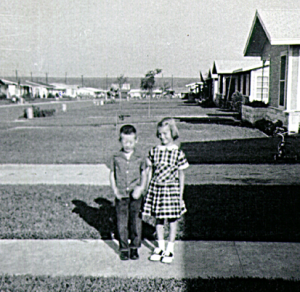 The Crestview neighborhood, north of Brentwood from Justin to Anderson, also began to be developed in the late 1940s. The photo at right was taken on Dartmouth Avenue in Crestview, with the “Violet Crown Hills” to the west in the background. It was the first day of school, 1956. In January 2015, Scott Hopkins called to say the photo is of him and his neighbor Janet. His parents built the house at 1516 Dartmouth.
The Crestview neighborhood, north of Brentwood from Justin to Anderson, also began to be developed in the late 1940s. The photo at right was taken on Dartmouth Avenue in Crestview, with the “Violet Crown Hills” to the west in the background. It was the first day of school, 1956. In January 2015, Scott Hopkins called to say the photo is of him and his neighbor Janet. His parents built the house at 1516 Dartmouth.
In 1950 and 1951, office and retail spaces were being advertised for rent at the new Violet Crown Shopping Center, with a new section already being developed to expand the center. On the northwest corner of North Lamar and Brentwood Street, the center was in the heart of Violet Crown Heights, Section 1. Four of the original businesses had “violet crown” in their names—a barber shop, beauty shop, drug store, and dry cleaners. The barber shop later was owned by Tom Cockrell. It closed on December 22, 2017. Richard Linklater shot the Emporium scenes for his film Dazed and Confused, released in 1993, at the center. (For a few years around 1930, there also were a Violet Crown Barber Shop and Violet Crown Beauty Shop in South Austin, at 1502 South Congress Avenue.)
Note: A plaque at the Violet Crown Shopping Center states that it opened in 1951 and was “Austin’s first shopping center.” According to newspaper accounts and other records, it was one of the earliest but not the first. More details here.
Beginning in 2003, the Brentwood and Crestview neighborhoods became the home of the Violet Crown Festival (2003-2007, 2009-2019), the nonprofit Violet Crown Community Works (2004-), our Voices of the Violet Crown community history project (2007-), Violet Crown Community Theater (about 2010-2012), and Violet Crown City Church (2020-), among others. Over the years, Austinites have created a variety of other “violet crown” businesses, organizations, a nature trail—even a drink, Violet Crown Soda. It was formulated by Todd Sanders of Roadhouse Relics and sold to Violet Crown Cinema, where it’s served today.
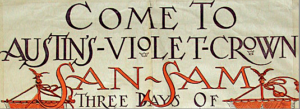 In early 2003, Brentwood and Crestview neighbors began planning the first Violet Crown Festival. At the Austin History Center, Jean Graham discovered a colorful poster (excerpt at left) for the Violet Crown San Sam Festival, held annually in the 1920s. We realized then that we, too, were contributing to the long-held tradition of celebrating Austin’s violet crown. Since 2003, people have come together for 16 spring festivals. And, in 2005 and 2009, more than 150 neighbors of all ages created festive artwork and violet hats, including the ones below, and participated in the Procession of the Violet Crowns at First Night Austin. They were led by local icon Domino the Pig. More about him here. View the film First Night W/ Domino & Friends here. The webpage “Just What Is a Violet Crown?” first appeared on the Voices of the Violet Crown website in July 2011, when the site was launched, and was last updated in September 2023.
In early 2003, Brentwood and Crestview neighbors began planning the first Violet Crown Festival. At the Austin History Center, Jean Graham discovered a colorful poster (excerpt at left) for the Violet Crown San Sam Festival, held annually in the 1920s. We realized then that we, too, were contributing to the long-held tradition of celebrating Austin’s violet crown. Since 2003, people have come together for 16 spring festivals. And, in 2005 and 2009, more than 150 neighbors of all ages created festive artwork and violet hats, including the ones below, and participated in the Procession of the Violet Crowns at First Night Austin. They were led by local icon Domino the Pig. More about him here. View the film First Night W/ Domino & Friends here. The webpage “Just What Is a Violet Crown?” first appeared on the Voices of the Violet Crown website in July 2011, when the site was launched, and was last updated in September 2023.
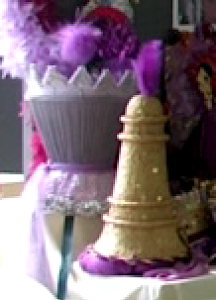 WOOLDRIDGE, BRANN, AND O. HENRY
WOOLDRIDGE, BRANN, AND O. HENRY
Although the author O. Henry is widely considered to be the person who “christened” Austin as the City of the Violet Crown in October 1894, the phrase was first published locally more than six years before.
By early 1888, prominent Austinite Alexander Penn Wooldridge was advocating for a new dam across the Colorado River flowing through the heart of Austin. His letter, entitled “Irrigation: The Great Desideratum [something needed or wanted] of Austin,” appeared in the January 1, 1888, Austin Daily Statesman. Around this time, Wooldridge—a lawyer, banker, and patron of education—also became president of the Statesman Corporation, the company that published the Austin newspaper. He likely contributed to an editorial in the Austin paper on January 31, 1888. It mentioned the “violet crown” of Austin, for possibly the first time in print. Here’s an excerpt:
No town in Texas possesses natural advantages superior to Austin. It is called the Capitol City, but situated as it is, upon hills crowned with violets, it might be called the “City of the Violet Crown,” whose purple tints are kissed by the rising and setting sun. Rich in educational institutions, this southern Athens unfurls her literary ensign, which shines like a meteor of jeweled thoughts.
Ancient Athens in Greece was known for its commitment to education. By the 1850s, Nashville, Tennessee, was known as the Athens of the South, for its longstanding support of higher education. The University of Nashville was founded in 1825, and the University of Texas at Austin in 1883. A. P. Wooldridge was instrumental in helping establish Austin as the location for the University of Texas.
Between 1888 and 1894, several dozen references to Austin as the City of the Violet Crown appeared in Austin and Galveston newspapers and in The College Echo (St. Edward’s College, Austin). All were published before a long article appeared in the Austin Daily Statesman on August 8, 1894. Here’s an excerpt:
May 5, 1890, was a memorable day in Austin . . . on that day the citizens of the City of the Violet Crown voted to build a granite dam across the Colorado River that would furnish motive power for thousands of factories and would furnish the city water and light . . .
The new dam was built by 1893, creating Lake McDonald (today’s Lake Austin). The dam failed in 1900, killing several dozen people. By 1940 it was replaced by the Tom Miller Dam.
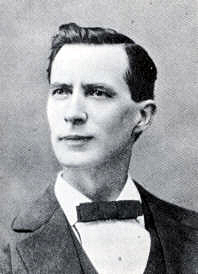 William Cowper Brann (1855-1898), right, is another of the earliest known writers to use “violet crown” to describe Austin. Brann was an Illinois native and longtime Texas journalist. He published his paper, The Iconoclast, in Austin for a few months beginning in August 1891. The article “The Garden of the Gods,” possibly published during that period, included this description:
William Cowper Brann (1855-1898), right, is another of the earliest known writers to use “violet crown” to describe Austin. Brann was an Illinois native and longtime Texas journalist. He published his paper, The Iconoclast, in Austin for a few months beginning in August 1891. The article “The Garden of the Gods,” possibly published during that period, included this description:
. . . Austin’s violet crown bathed in the radiance of the morning or arched with twilight’s dome of fretted gold.
Beyong his flowery language, Brann appeared to be critical of prominent Texans such as A. P. Wooldridge, who advocated for the granite dam and other development as a way to expand the Austin economy and attract new residents to the city:
Much has been written of Texas by immigration boomers, “able editors” and others, with an eye single to the almighty dollar. Its healthfulness, delightful climate, undeveloped resources, churches, schools, etc., have been expatiated upon times without number, but little has been said of its transcendent beauty . . . There must be a few people in this gain-grabbing world not altogether indifferent to the beauties of nature . . .
In 1891, William Sydney Porter (1862-1910), later known as the author O. Henry, worked at a local bank, had begun writing, and knew Brann. When Brann’s Iconoclast was unsuccessful, he sold the paper and printing press to Porter. In 1894, Brann relocated to Waco, Texas, where he resumed publication of The Iconoclast, after being given permission to use the name again.
By October 1894, Austin already was very well known as the City of the Violet Crown when O. Henry’s short story “Tictocq: The Great French Detective” was published with this description:
The drawing-rooms of one of the most magnificent residences in Austin are a blaze of lights . . . The occasion is the entree into society of one of the fairest buds in the City of the Violet Crown . . . Austin society is acknowledged to be the wittiest, the most select and the highest bred to be found southwest of Kansas City.
FROM ATHENS TO AUSTIN, A SPAN OF 2500 YEARS
Wooldridge, Brann, and O. Henry likely were inspired by other, much earlier, authors. The Greek poet Theognis, born about 550 B.C., described the purple hue of the evening sky over Hymettus, a mountain near Athens, Greece, as a violet crown. In 1894, E. Cobham Brewer suggested it was a reference to Ion, a king crowned in Athens. His Dictionary of Phrase and Fable provides more detail:
Ion (a violet) was a representative king of Athens, whose four sons gave names to the four Athenian classes; and Greece, in Asia Minor, was called Ionia. Athens was the city of “Ion crowned its king” or “of the Violet crowned.” I do not think that Athens was called from “the purple hue which Hymettus assumed in the evening sky” [as described by Theognis].
Over the years, writers from Aristophanes (400 B.C.) to Plutarch (100 A.D.) to Disraeli (1844) to Oscar Wilde (1878) described Athens as the City of the Violet Crown.
By the end of the nineteenth century, Austin shared the designation. Its popularity has continued into the twentieth and now the twenty-first centuries.
1914 • Dr. John Preston, Superintendent of the State Asylum (now the Austin State Hospital), described the land north and west of the hospital, which is between Guadalupe and North Lamar and south of West 45th Street:
On the north . . . stretch rich farming lands that were once illimitable prairies. Westward . . . is a chain of hills which make a beautiful purplish background for the intervening fields in various shades of green and gold.
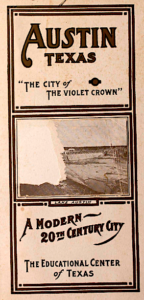 1917 • Austin published a promotional booklet, Austin Texas: The City of the Violet Crown, left. It features photographs of prominent businesses, homes, Austinites, and the “Violet Crowned Hills,” and a poem, “Austin,” by Nannie Hillary Harrison. It begins: “Proudly thou sittest upon violet crowned hills.”
1917 • Austin published a promotional booklet, Austin Texas: The City of the Violet Crown, left. It features photographs of prominent businesses, homes, Austinites, and the “Violet Crowned Hills,” and a poem, “Austin,” by Nannie Hillary Harrison. It begins: “Proudly thou sittest upon violet crowned hills.”
1920 • The first Violet Crown San Sam Festival was held in the spring in Austin. A contest was held to name the event, with the winning entry reflecting both the Battle of San Jacinto and Sam Houston in the name. The event included a parade, queen’s coronation, and many other activities. It was the first of eight annual events coordinated by the Order of the Violet Crown, an Austin-based civic group, patterned after the Order of the Alamo in San Antonio. The 1921 event marked the centennial of Stephen F. Austin’s arrival in Texas and featured a colorful poster (see excerpt above).
1924 • Austin businessperson and philanthropist Clara Driscoll Sevier founded the Violet Crown Garden Club, still active today. Sevier lived at Laguna Gloria on Lake Austin, today part of The Contemporary Austin.
1925 • The Violet Crown Home was built at 1504 West Lynn in Austin, as part of a project with the Austin American-Statesman to build the “ideal home.” It was designed by prominent Austin architect Hugo Kuehne and is still a vital part of the Old Enfield neighborhood.
1934 • An article in the Marshall (Texas) News Messenger described how most of the children visiting the Texas Capitol in Austin first want to visit the top of the dome:
Elevators take visitors to the fourth story. From there it is a long and dizzy climb, part of it on a winding stair. Views of Austin, the Colorado river valley, the University of Texas, and the “violet crown” of hills about Austin rewards those who make the climb.
1938 • Lyndon Baines Johnson, Texas congressman and later U. S. President, gave a radio address on January 23 known as Tarnish on the Violet Crown. In it, he described the substandard housing he had seen firsthand in Austin, and he advocated for public housing. Within a few years, Santa Rita Courts (for Mexican American families), Rosewood Courts (for black families), and Chalmers Courts (for white families) were built in East Austin. All three finally were desegregated in January 1968. Today, Santa Rita Courts and Rosewood Courts still provide affordable housing; Chalmers Courts mostly has been demolished.
1939 • Scarbrough’s department store advertised “Centennial Colors,” six colors selected as “important fashion and accessory shades for Spring and Summer.” They included Austin rose, Barton Springs Blue, Violet Crown, Citrus, Texas Blue, and Lariat. (Austin became the capital of Texas in 1839.) Scarbrough’s was located at 522 Congress Avenue in Austin from 1892 to 1982. The Scarbrough Building, Austin’s first skyscraper and original location of the popular department store, still is in use.
By the late 1940s, Violet Crown Heights was developed in the Brentwood neighborhood of Austin. And, people living here today still see the violet crown at sunset, including David, who described his experience:
I have lived in Austin most of 50 years and have always heard about the “Violet Crown.” Just as the sun went down yesterday, I was standing outside, and the sky went purple. I live on Koenig near Woodrow. I probably looked like an idiot staring up at the sky, but it was worth it. You could have knocked me over with one finger. I always thought it was a legend, or folklore, or whatever. It was incredibly beautiful and real, and I saw it. I would say lavender is the closest color to what I saw. I was so bowled over I forgot to take a picture. I ran inside for a camera a few minutes later, but it was gone. It was only visible for 2 or 3 minutes. Amazing.
